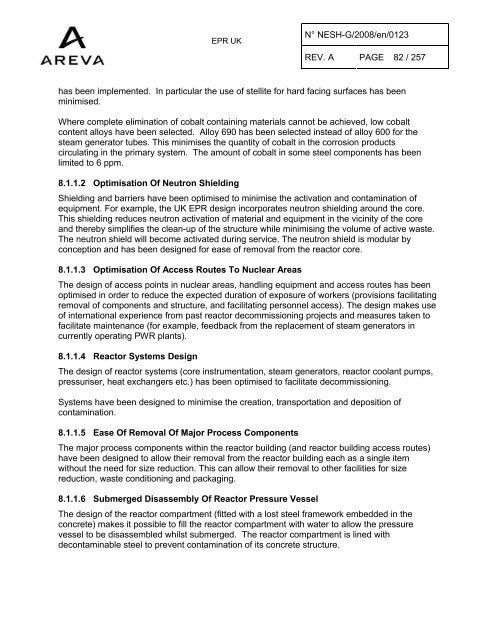Solid Radioactive Waste Strategy Report.pdf - UK EPR
Solid Radioactive Waste Strategy Report.pdf - UK EPR
Solid Radioactive Waste Strategy Report.pdf - UK EPR
You also want an ePaper? Increase the reach of your titles
YUMPU automatically turns print PDFs into web optimized ePapers that Google loves.
<strong>EPR</strong> <strong>UK</strong><br />
N° NESH-G/2008/en/0123<br />
REV. A PAGE 82 / 257<br />
has been implemented. In particular the use of stellite for hard facing surfaces has been<br />
minimised.<br />
Where complete elimination of cobalt containing materials cannot be achieved, low cobalt<br />
content alloys have been selected. Alloy 690 has been selected instead of alloy 600 for the<br />
steam generator tubes. This minimises the quantity of cobalt in the corrosion products<br />
circulating in the primary system. The amount of cobalt in some steel components has been<br />
limited to 6 ppm.<br />
8.1.1.2 Optimisation Of Neutron Shielding<br />
Shielding and barriers have been optimised to minimise the activation and contamination of<br />
equipment. For example, the <strong>UK</strong> <strong>EPR</strong> design incorporates neutron shielding around the core.<br />
This shielding reduces neutron activation of material and equipment in the vicinity of the core<br />
and thereby simplifies the clean-up of the structure while minimising the volume of active waste.<br />
The neutron shield will become activated during service. The neutron shield is modular by<br />
conception and has been designed for ease of removal from the reactor core.<br />
8.1.1.3 Optimisation Of Access Routes To Nuclear Areas<br />
The design of access points in nuclear areas, handling equipment and access routes has been<br />
optimised in order to reduce the expected duration of exposure of workers (provisions facilitating<br />
removal of components and structure, and facilitating personnel access). The design makes use<br />
of international experience from past reactor decommissioning projects and measures taken to<br />
facilitate maintenance (for example, feedback from the replacement of steam generators in<br />
currently operating PWR plants).<br />
8.1.1.4 Reactor Systems Design<br />
The design of reactor systems (core instrumentation, steam generators, reactor coolant pumps,<br />
pressuriser, heat exchangers etc.) has been optimised to facilitate decommissioning.<br />
Systems have been designed to minimise the creation, transportation and deposition of<br />
contamination.<br />
8.1.1.5 Ease Of Removal Of Major Process Components<br />
The major process components within the reactor building (and reactor building access routes)<br />
have been designed to allow their removal from the reactor building each as a single item<br />
without the need for size reduction. This can allow their removal to other facilities for size<br />
reduction, waste conditioning and packaging.<br />
8.1.1.6 Submerged Disassembly Of Reactor Pressure Vessel<br />
The design of the reactor compartment (fitted with a lost steel framework embedded in the<br />
concrete) makes it possible to fill the reactor compartment with water to allow the pressure<br />
vessel to be disassembled whilst submerged. The reactor compartment is lined with<br />
decontaminable steel to prevent contamination of its concrete structure.

















